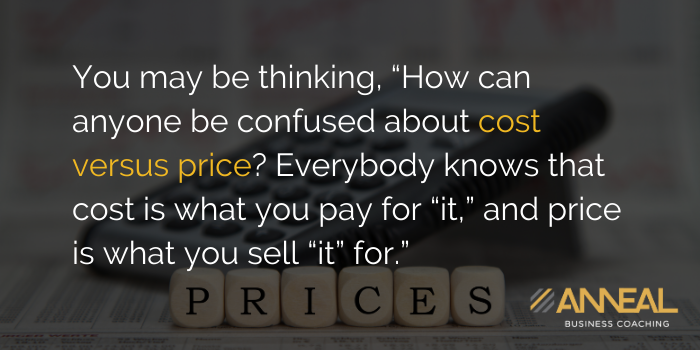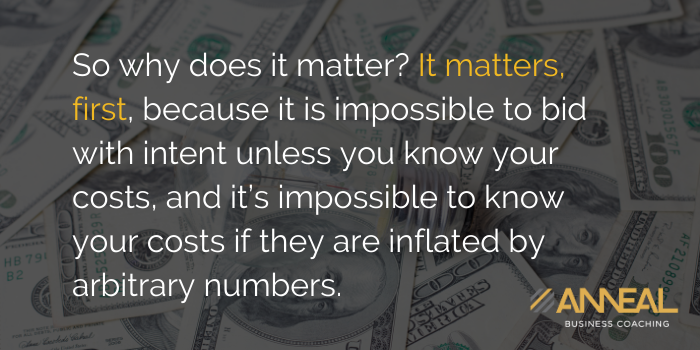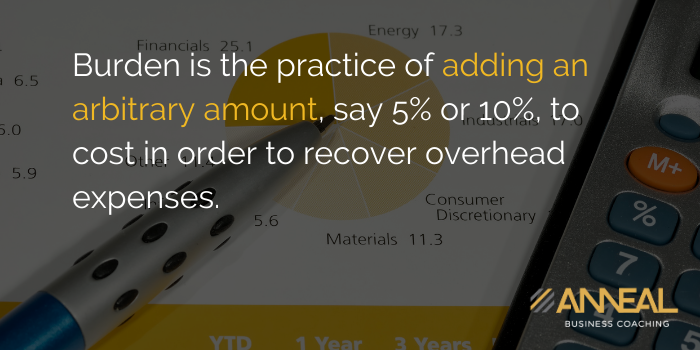In parts one and two of this series, I listed four common obstacles to bidding with intent:
In this article we’ll look at obstacle number three, confusion about price versus cost.
The first two articles talked about a target margin and how to use it to price bids. It’s not difficult to come up with a target margin, but using it depends on understanding the difference between cost and price. You may be thinking, “How can anyone be confused about cost versus price? Everybody knows that cost is what you pay for “it,” and price is what you sell “it” for.”

It sounds simple, but there is a lot of confusion about the “what you paid for it” part. I’ll use an example to show what I mean.
I recently sat with a new contractor client to learn his bidding process. He confessed his bids were “all over the place.” Sometimes he won jobs he wished he hadn’t. Other times he lost what he thought were low-price bids to competitors who underbid him at prices “below my cost.” His bids were loosely based on cost, but I discovered that much of what he called cost was really price. That was messing him up.
He showed me his “cost” estimates for a bid he was working on which included the following items and costs.
|
Reported Cost |
||
|
Pressure test lines |
$250 |
Price |
|
Dumpster rent |
$1,200 |
Price |
|
Concrete (12 yds) |
$2,500 |
Price |
|
Rebar |
$600 |
Cost |
|
Labor |
$4,000 |
Price |
|
Total cost |
$8,550 |
|
I asked him what went into the first item, pressure testing lines.
“Not much.” he said, “I just put a gauge on the line and read what it says.”
I asked him where the $250 cost number came from.
“That’s what I charge to do it.”
“Hmmm… that sounds like a price, not a cost, right?”
We went through each item in the list and found that rebar was the only item he had listed at actual cost. Labor cost was based on his “day rate,” and dumpster rent and concrete were rounded up to arbitrary numbers for reasons he couldn’t remember.
I asked him to reprice the items using actual cost, the amounts he would have to write checks for if he won the job. His revised estimates looked like this:
|
Actual cost |
||
|
Pressure test lines |
$25 |
Cost |
|
Dumpster rent |
$900 |
Cost |
|
Concrete (12 yds) |
$1,550 |
Cost |
|
Rebar |
$600 |
Cost |
|
Labor |
$3,000 |
Cost |
|
Total actual cost |
$6,075 |
|
Total “reported cost” was $8,550. Total “actual cost” was $6,075. The first estimate was $2,475 (41%) higher than his actual cost!
So why does it matter? It matters, first, because it is impossible to bid with intent unless you know your costs, and it’s impossible to know your costs if they are inflated by arbitrary numbers. Second, if he used the formula from article two of this series to price his bid, he would ratchet up his price by charging margin on the margins already included in cost.

To see the effect of price-ratcheting, assume he bids using his first reported cost estimate with a 40% target margin:
|
Intentionally bid price at 40% target margin |
|||
|
Reported cost |
$8,550 |
/.60 |
$14,250 |
|
Actual cost |
$6,075 |
/.60 |
$10,125 |
A bid based on the $8,550 cost estimate would result in a 57% margin rather than his 40% target margin.
$14,250 price - $6,075 actual cost = $8,175 gross profit
$8,175 gross profit / bid price of $14,250 = 57% margin.
That would be a great margin if he could get it, but the bid could easily price him out of the market without his ever knowing why. Because he bid 57% by accident, rather than with intent, he would likely convince himself that the market wouldn’t bear his 40% target margin (which was really a 57% margin), and he would begin the downward spiral toward lower and lower prices.
Don’t let that happen to you. Know your target margin, and use your actual costs to come up with prices. If you want to raise your prices, do it intentionally by raising your target margin higher and higher until the market won’t bear it. That way, you’ll have a good idea of what the market will bear and can bid accordingly. Bid with intent, not by accident.
There is another distorting factor I often see included among bid costs: Burden. Burden is the practice of adding an arbitrary amount, say 5% or 10%, to cost in order to recover overhead expenses. We all have to recover our overhead expenses, but THAT’S WHAT A TARGET MARGIN DOES! (Not only overhead, but also debt payments and target profit.)

Burdening is just another way of distorting cost, but this time without allocating the distortion among individual items. Let’s suppose my contractor decided to add 10% burden to his first cost estimate. His new cost estimate would look like this:
|
Reported Cost plus something for Overhead |
||
|
Pressure test lines |
$250 |
Price |
|
Dumpster rent |
$1,200 |
Price |
|
Concrete (12 yds) |
$2,500 |
Price |
|
Rebar |
$600 |
Cost |
|
Labor |
$4,000 |
Price |
|
10% of “reported cost” for overhead |
$850 |
Burden |
|
Total |
$9,400 |
Total cost |
With burden included in cost, his bid target margin bid would look like this:
$9,400 reported cost plus burden / .60% variable costs = $15,666 price
$15,666 price - $6,075 actual cost = $9,591 gross profit
$9,591 gross profit / $15,666 bid price = 61% percent margin
His target was 40%, but his bid was at 61%. He could have hit his 40% target margin with a price of $10,125, but he would more likely lose the bid because burdening and confusion about price vs. cost led him to price the job at $15,666. His experience might warn him that the $15,666 price is too high, so he’d make some arbitrary adjustment to reduce it based on how he felt that day or how badly he needed the work. Arbitrary adjustments are the opposite of intentional bidding.
Intentional bidding means bidding at a target that pays your overhead, your debt, and additional profit target beyond debt. If you want to raise your prices, do it with adjustments to your margin, not with inflated cost estimates or by arbitrary burden amounts.
Once you have a target margin, you have to bid at that price. In my next article, I’ll talk about having the confidence to bid with intent and to make changes necessary to do it.
If you’re interested in working together to improve your margins, establishing bid processes, and more, please contact me. I’d enjoy talking to you.